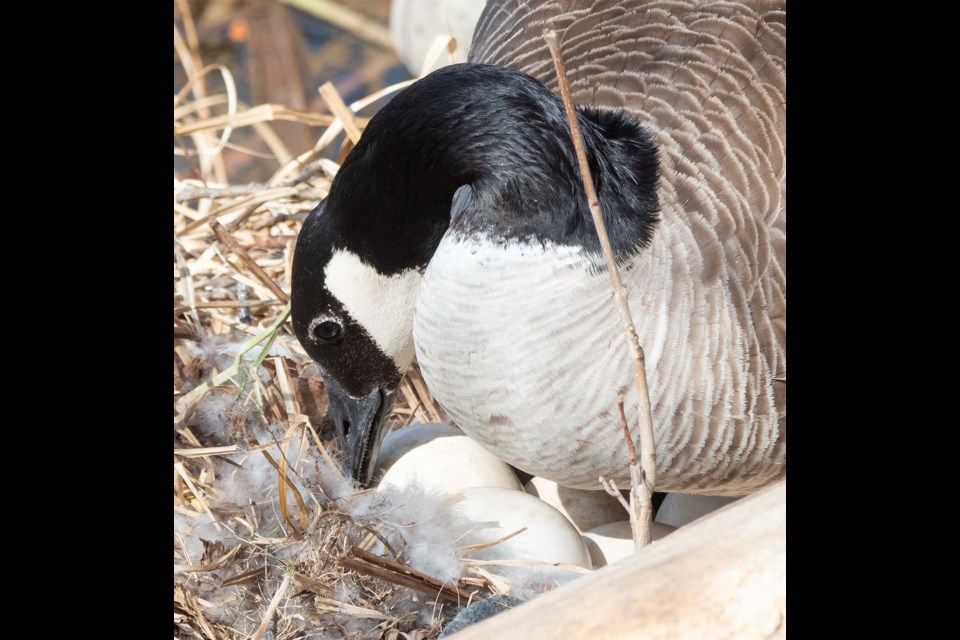I got some new neighbours last month: a pair of magpies building a nest in a tall spruce tree.
The nest started out as a few twigs and has since grown into a small tumbleweed. Both birds have been flying back and forth for weeks, piling on twigs and sticks and obsessively rearranging them, presumably for good feng shui. How that massive jumble of branches stays up there intact is beyond me.
It’s springtime in St. Albert, and nest construction is well underway. Local ornithologists will be on the lookout for birds building homes in their neighbourhood, eager for a glimpse of eggs and chicks.
Flying home-builders
Birds build nests so they have a safe place to sit and incubate their eggs, said Jocelyn Hudon, curator of ornithology at the Royal Alberta Museum. Many get an early start on construction to make sure their eggs hatch when there is lots of food around for their babies.
The great horned owl is probably the earliest nester in St. Albert, as they start in January, said St. Albert birder Percy Zalasky. (Some may have very fluffy owlets by now.) Magpies are busy building now, and will be joined soon by American crows, which have started to return to this region. Robins and other passerines are likely still a few weeks away from St. Albert, with most waterfowl even further out — save for Canada geese, of course, who have been honking from rooftops for several weeks now.
“They’re walking around on the ice at Big Lake and the [John E.] Poole wetland,” Zalasky said, and will be among the first waterfowl on nests this year.
Every bird appears to be born with the knowledge of how and where to build a nest, said Kim Blomme, director of research and policy with WILDNorth (St. Albert’s wildlife rescue group). Some nest in trees or branches, others on the ground or in your planters. Some pick “weird” spots for nests such as rooftop balconies, either mistaking them as good spots or seeing them as safe from predation.
“We’ve had robins that have built their nest on a canoe [in a garage],” Blomme said, and many cases of house sparrows setting up shop in dryer vents.
“That’s not a good spot.”
WILDNorth recommends residents check canoes and vehicles they have in storage for animal nests prior to using them for this reason, Blomme said.
Many designs
Magpie nests like the one by my place are large domes that typically measure 76 centimetres tall and 51 wide, reports the Cornell Lab of Ornithology. The males gather sticks for the exterior, while the female builds a grass-lined mud cup inside. The whole structure can take up to 40 days to build.
St. Albert residents are most likely to see robins’ nests, as robins are pretty common, Blomme said. Look for a cup made from dry grass and mud — expect a muddy robin, too, as they pack the mud with their chests.
“Every robin’s nest is exactly the same diameter,” Blomme said, designed so that a robin can cover all the eggs in it.
Sharp-eyed viewers might spot red-winged blackbird nests made from reeds and cattails around the John E. Poole boardwalk, Zalasky said. (Angry female blackbirds harassing you is a sure sign of a nearby nest.) Barn and cliff swallows nest underneath the boardwalk in mud nests, while tree swallows frequent the bird boxes found throughout the area. St. Albert also sometimes host Baltimore orioles, which weave cup-shaped nests that hang from trees and sway in the wind.
Privacy, please
Blomme said it’s hard to say how to find birds’ nests, as each bird has its own preferred style and habitat and wants to hide from predators. If you do find one, leave it alone: it is illegal in Canada to disturb any migratory bird nest with a live bird or viable egg in it (or at any time, in the case of 18 specific species), and if you get too close, the bird might abandon its nest. Instead, enjoy the nest from a distance. If a bird has nested in a troublesome spot (say, a goose on your balcony), call WILDNorth for advice.
“Most bird nesting seasons are very short,” Blomme said, so you can usually wait them out.
Those magpies appear to have finished their nest in recent weeks, but the local house sparrows have started eyeing up my dryer vents. Maybe I’ll get some new neighbours soon?



